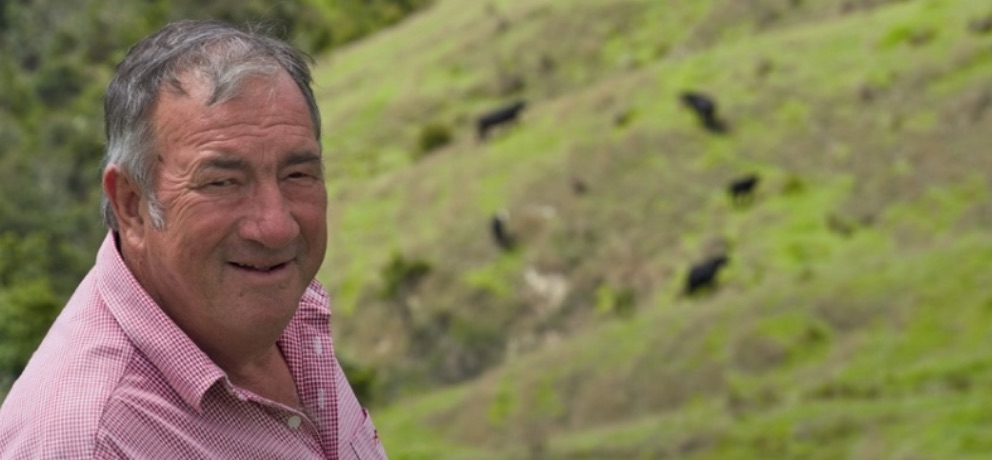In 2002, after decades of production-orientated farming, John Wood set the challenge of taking the 440ha mix of clay and rubbly volcanic soils situated on some of the steepest farmland in the region, into a new era – restoring and protecting its natural heritage, while building on its high productivity. This meant fencing off 11 areas of remaining bush and planting some 600 natives (kauri, rimu, puriri, taraire), per year in these areas. A new emphasis on nurturing the waterways within the farm’s deep valleys has been established. To complement these changes a new direction in sustainable fertiliser practice was also implemented.
One of John’s first priorities was to keep the kikuyu grass that was smothering most areas of the farm under control, as well as improve the pasture quality and clover growth. The early soil tests showed the Olsen P was reasonable but the pH was low, so the early fertiliser plan involved applying lime and superphosphate alternately, with extra nitrogen when needed. He noticed the higher they raised the pH, the higher the Olsen P rose. While this was achieving the desired outcome, John wondered whether it could be achieved in a more cost-effective and efficient way. “Avoca Lime Company had just begun manufacturing dicalcic phosphate the traditional Hatuma way and it got me thinking about what the old guys used to do with reverted super,” John recalls. “Also, I used to hate seeing the plane spreading the superphosphate before a week of rain and knowing where it was going to end up. In this wet climate, it made sense to use a fertiliser that was going to stick around and work longer rather than end up in the waterways.”
John initially contacted Avoca and used a blend of Hatuma Dicalcic Phosphate® and lime on half the farm, and continued applying superphosphate on the other. But the results from the dicalcic blend made him change to spreading it across the whole property. Six years on and John is still seeing the benefits from his decision. “The pasture is like a Rolls Royce compared to an old Ford now. With the extra fencing we put in, the stock used to be forced onto ropey and unpalatable kikuyu, but the clover content has improved so much that it’s growing amongst the kikuyu on the hill country and in patches that used to be just bare ground. It’s actually increased the palatability of the kikuyu and, in a dry summer, we’re pleased withit because it gives the stock something to eat. You can tell the soil is in better condition because the farm hangs on longer during a drought and is the first place to respond when the rain comes. There are more earthworms, the cowpats recycle quicker, and the pasture is cleaner. I’m top-dressing a lot more efficiently now by having the one mix that does everything.”
“I put a lot of pressure on the pasture but the Hatuma Dicalcic Phosphate keeps the stock well fed. With the extreme seasons lately, I sometimes wonder how the stock will cope at 9.5su/ha but the overall production has actually gone up. Part of that is due to the fewer animal health issues we have to deal with. The stock have very good conception rates and we’re drenching the ewes only once a year now. We normally fatten everything, depending on the season. We purchased a rundown 65ha block four years ago that had virtually no regrowth. By using Hatuma Dicalcic Phosphate, the transition to bringing it up to the same production level as the main farm was quick. We run all our hoggets over there now and finish our heifers. These days it’s not uncommon for the block’s growth to get away on us.”
“The Hatuma Dicalcic Phosphate is much more sustainable than other options out there. While it was a three-to-four-year apprenticeship, the Hatuma Dicalcic Phosphate has proven itself on the farm without a doubt, in every way. We’re getting an extra response and better animal performance, and we’re not pouring on the high- analysis stuff to get it. We’re putting on less phosphate now and we don’t use nitrogen any more, but we’re keeping up the lime. I’ve been happy with the progress of improvements of the regular soil test results and they prove we’re not mining the phosphate. I’d rather do things sustainably and grow the humus in the ground to maintain production. I wouldn’t think of using anything else; we simply tailor the product with trace elements like selenium, magnesium and salt to suit our requirements.”
“The customer service has been great. Avoca’s Managing Director, Bryce Manderson, has been excellent to deal with and completely understands the product. We’re always working with the weather but Bryce makes sure the Hatuma Dicalcic Phosphate is always there when we need it and that suits the business just fine. The pilots never have an issue spreading the product.”
“In the future, we will need to be more aware of producing a product to certain specifications, and traceability will take more of a role in this. So while we’re looking at the quality of the product leaving the place, we’re also thinking about adding value to the whole farm’s sustainability and building biodiversity to complement the story of that product. The return of native birds such as kereru and tui has been really noticeable; it’s fantastic to hear them in abundance amongst the grazing stock. I think we’re reaching this idealism here more quickly than originally imagined.”

